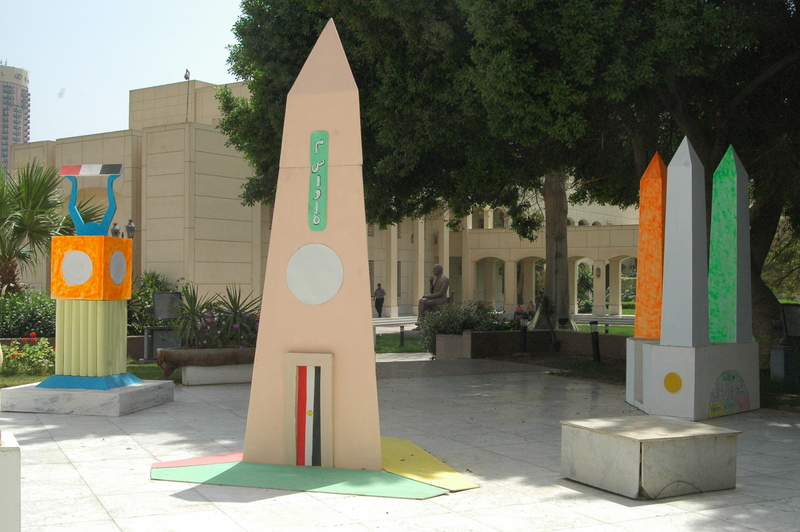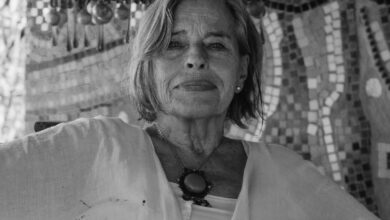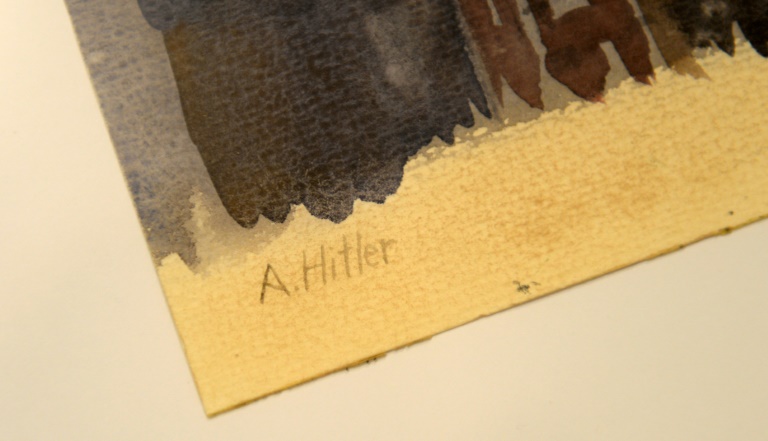
Ramzy Mustafa’s new exhibition in the Bab Gallery at the Museum of Modern Egyptian Art employs many of the familiar tropes of celebratory “Revolution Art,” but despite layers of overt symbolism and some very familiar imagery, there is something just a little bit strange and surprising about his joyful monumental visions.
“Egypt Above All” is Mustafa’s ode to Egypt after 25 January, and he has filled the small gallery with drawings and sculptures that function as models for potential public monuments to memorialize and embody the energy of the revolution, alongside large photo collages of protesters, slathered with red, black and white stripes, and splashes of green paint. The title of the show may suggest an overt nationalistic tone, reminiscent of the classic rulers’ discourse seen under Hosni Mubarak as well as his current military successors. The line, "Egypt above all," is employed to undermine voices of dissidence, whose quest, authorities believe, is ultimately to destabilize their beloved Egypt. But Mustafa's “Egypt Above All” is oblivious to this reference and rather delves into the grandeur of Egypt's revolution, which he frames in a rather essentialist form by ascribing to authorities some pharaonic motives.
In the courtyard at the entrance to the gallery, visitors will first encounter several larger monumental models. The roughly constructed, pharaonic-inspired forms, painted in neon shades of pink, orange and green, jut out like playful school craft projects among the bronze and stone statues of the museum’s sculpture garden, setting the tone for an exhibition that feels out of place in the polished, institutional confines of the Opera House grounds.
Mustafa’s work is full of uneven edges and paint that slips outside of its intended space. The pieces feel hastily, almost carelessly assembled, and the entire collection has such a strong tone of naiveté that it is tempting to classify the work as outsider art. But the 86-year-old Mustafa is formally trained and a professor at the Helwan University Faculty of Fine Arts. Mustafa has exhibited internationally and in Egypt for decades. He describes himself as a “pop art man,” a quality manifested in this work simply by the fact that he works in collage, creating pastiches of heavily symbolic elements. He falls in with a handful of older artists, such as George Bahgory, who exhibited his collection of paintings of the revolution at Masar Gallery in March, who are now attempting to represent the 18 days and address the changes taking place in Egypt in often illustrative and celebratory ways. But Mustafa’s work, despite being expressly intended to glorify, mythologize and monumentalize, embodies a kind of wide-eyed approach that is intriguing if only because it is so unexpected.
Mustafa has created models for monuments that ideally would be made into actual, monument-sized memorials to the revolution. Mustafa tells Egypt Independent, “I want them to be huge.”
The constructions vary in form, but stay true to a basic formula. Each monument has a large base, which is meant to house a museum which will, according to Mustafa, “hold the history of the revolution for future generations.” A pillar or obelisk form extends skyward from the museum base. The protruding edifices are detailed with small Egyptian flags and Mustafa’s exuberant, sun-soaked colors. Mustafa envisions them as embodiments of the energy of change, surging upwards into the sky. The forms are meant to be representative of the idealized path of revolution, moving forward steadily, sometimes focusing in on a point, in the form of an obelisk, or sometimes blossoming open into a beautiful tulip.
In one illustrated prototype, Mustafa creates a representation of the confusion of the revolution, with a pillar that breaks down halfway up into a swirl of writhing colors before again solidifying and continuing its upward, forward movement. Several other models take a more obvious approach, showing a human form at the top of the pillar, arms outstretched, lifting the stone top of the monument and raising it upwards.
The urge to monumentalize and encapsulate revolution in Egypt has expressed itself repeatedly in work representing the 18-day uprising or the events of the past year more generally, and it has been discussed before in the context of this work that erecting stone monuments and museums filled with artifacts of the revolution may be the least productive way to represent or contribute to the dynamism and unpredictability of this moment in Egypt. Mustafa’s pieces have very little to do with the reality of anything that has happened over the past year and a half, but the childlike openness and optimism of his work, both in its ideas and forms, makes his strange constructions appealing.
Mustafa has uncomplicated feelings about this moment in Egypt. “It is a nice revolution,” he says. “It is a beautiful revolution. It is still young.”
This is precisely the impression given off by his cheerful colors and particularly the curling, entwined shapes of the drawn monuments, many of which take forms that would be difficult to reproduce in a paper model. Mustafa’s drawings also do not suffer from the same roughness of construction that his photo-montages and paper models do. One can imagine that the actual life-size stone behemoth would be a jubilant expression of hopeful joy.
But Mustafa’s photographic images have fewer redeeming qualities than his quirky monuments. They are messy and crude, with the stripes of the Egyptian flag running gratuitously back and forth across the canvas. And with such a large amount of sophisticated, stimulating work being made in Egypt, Ramzy Mustafa’s school-craft-project work seems a strange choice, particularly for a gallery situated amid the rarefied institutions of the Egyptian culture scene, adjacent to the Museum of Modern Egyptian Art and across from the Opera House. But however naïve and simplistic, Mustafa’s sculptures display a very idiosyncratic vision, and even if Mustafa lives in a shining dream world of pharaonic monuments and flashing colors, it is nonetheless interesting to see what the increasingly abstracted idea of revolution means for this particular artist.
“Egypt Above All” is on view until 13 May at the Bab Gallery at the Museum of Modern Egyptian Art, Cairo Opera House Grounds in Gezira, Zamalek. It open from 10 am to 2 pm and 5:30 pm to 10 pm, Tuesday through Sunday.




